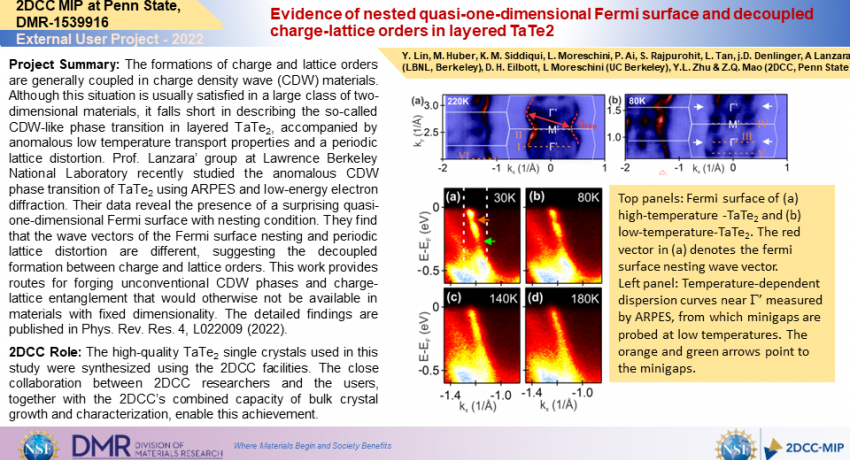What Has Been Achieved:
The formations of charge and lattice orders are generally coupled in charge density wave (CDW) materials. However, this work reveals the presence of a surprising quasi-one-dimensional Fermi surface with nesting condition and find that the wave vectors of the fermi surface nesting and periodic lattice distortion are different, suggesting the decoupled formation between charge and lattice orders.
Importance of the Achievement:
This work provides routes for forging unconventional CDW phases and charge-lattice entanglement that would otherwise not be available in materials with fixed dimensionality.
Unique Feature(s) of the MIP that Enabled this Achievement:
The 2DCC researchers not only synthesized TaTe2 single crystals using the chemical vapor transport method through fine-tuning of the temperature gradient and the transport agent vapor pressure, but also carefully characterized the grown crystals using XRD and EDS and showed they have minimal disorders. The combined capacity of bulk crystal growth and advanced characterization at 2DCC-MIP enables this achievement
Publication:
Yi Lin , Maximillian Huber, Sangeeta Rajpurohit, Yanglin Zhu, Khalid M. Siddiqui, Daniel H. Eilbott, Luca Moreschini, Ping Ai, Jonathan D. Denlinger, Zhiqiang Mao, Liang Z. Tan , and Alessandra Lanzara, Phys. Rev. Res. 4, L022009 (2022).
Acknowledgements:
This work was primarily supported by the U.S. Department of Energy (DOE), Office of Science, Office of Basic Energy Sciences, Materials Sciences and Engineering Division under Contract No. DE-AC02-05CH11231 (Ultrafast Materials Science Program No. KC2203). This research used resources of the Advanced Light Source, a U.S. DOE Office of Science User Facility under Contract No. DE-AC02-05CH11231. Support for crystal growth and characterization was provided by the National Science Foundation through the Penn State 2D Crystal Consortium–Materials Innovation Platform (2DCC-MIP) under NSF Cooperative Agreement No. DMR-1539916. Theoretical efforts were primarily supported by the Computational Materials Sciences Program funded by the U.S. Department of Energy, Office of Science, Basic Energy Sciences, Materials Sciences and Engineering Division. Additional support for ARPES intensity simulations was provided through the Molecular Foundry, a DOE Office of Science User Facility supported by the Office of Science of the U.S. Department of Energy under Contract No. DE-AC02-05CH11231.
Credits/Names: Y. Lin, M. Huber, K. M. Siddiqui, L. Moreschini, P. Ai, S. Rajpurohit, L. Tan, j.D. Denlinger, A Lanzara (LBNL, Berkeley), D. H. Eilbott, L Moreschini (UC Berkeley), Y.L. Zhu & Z.Q. Mao (2DCC, Penn State)
Download PDF Version: 1539916_2DCCMIP_2022_Evidence of nested quasi-one-dimensional Fermi surface.pdf
Year of Research Highlight: 2022
Select a Highlight Type: User Highlight
